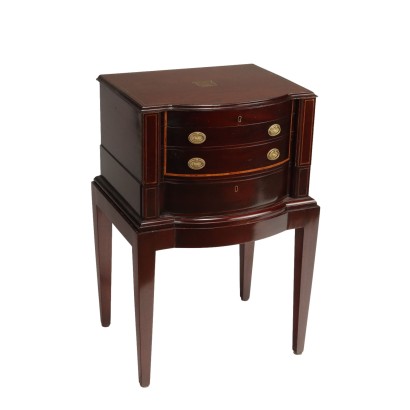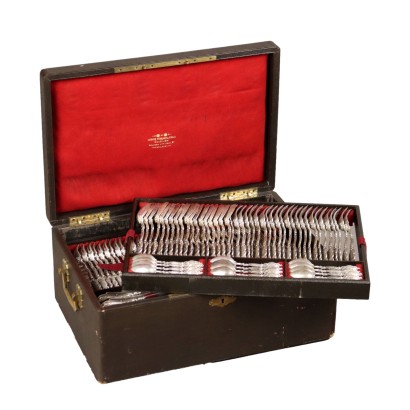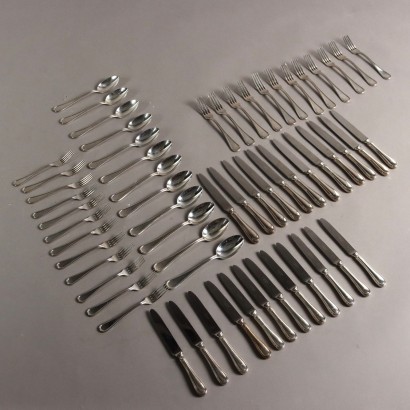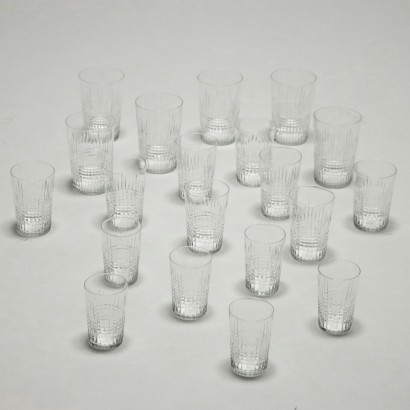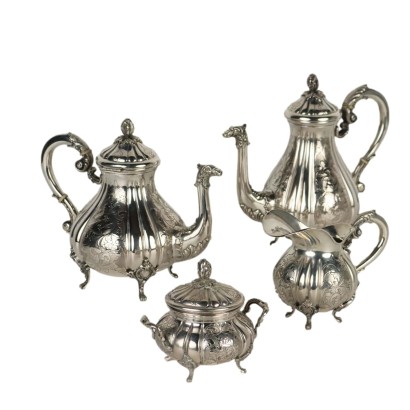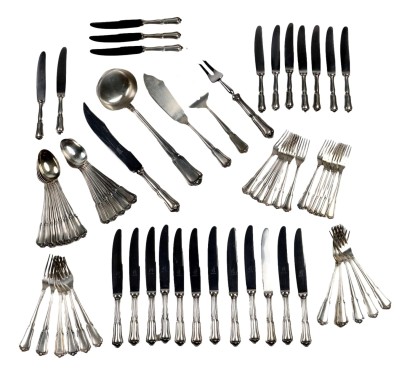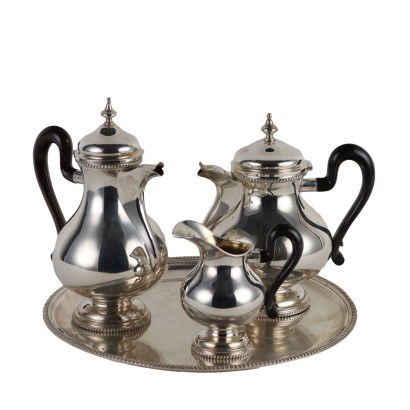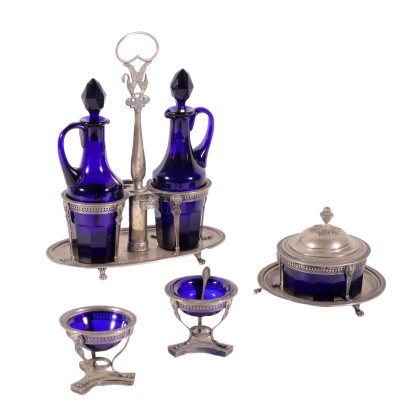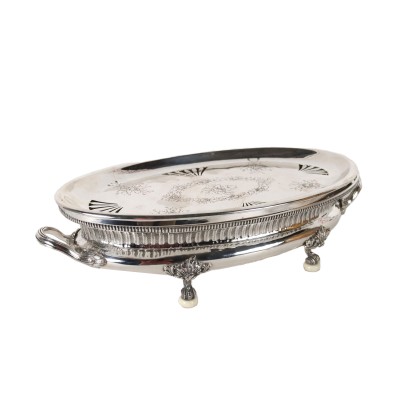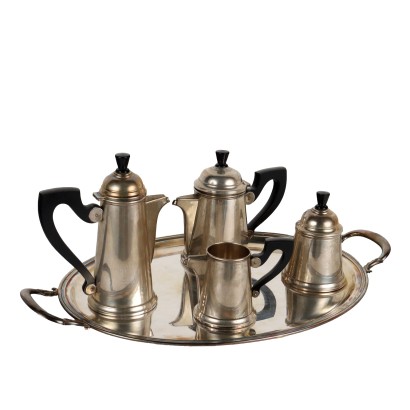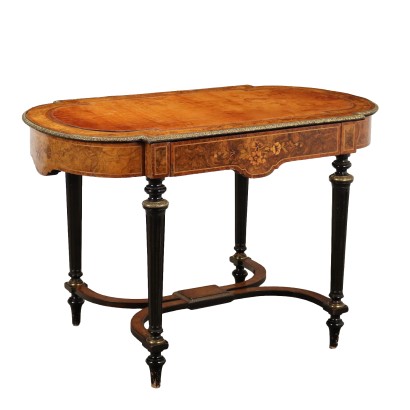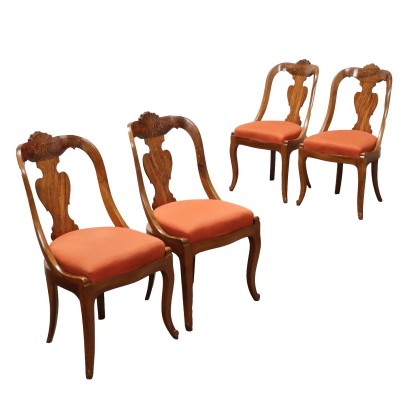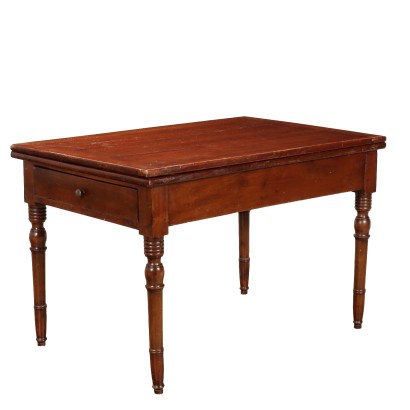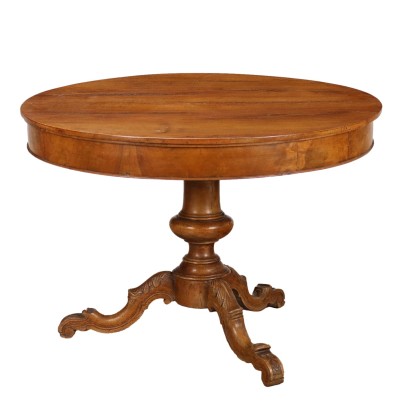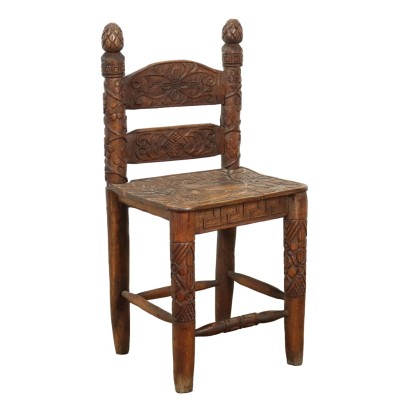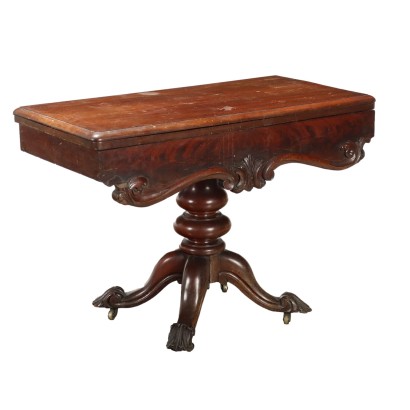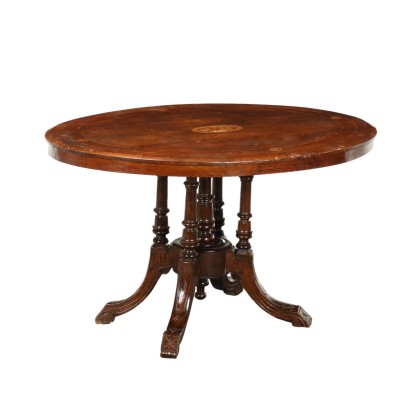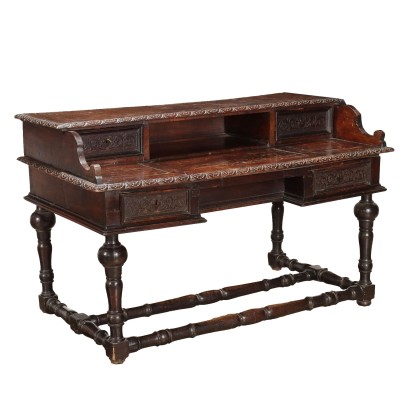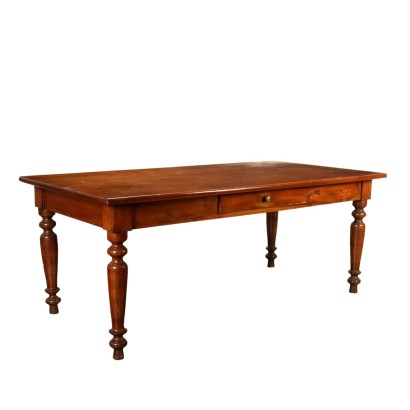Antique Silver Cutlery Set with Cabinet Hungary XIX Century - Hungary, Late XIX Century
Features
Hungary, Late XIX Century
Age: 19th Century / 1801 - 1900
Origin: Hungary
Main essence: Silver Fir , Maple , Brazilian Rosewood , Mahogany
Material: Silver , Dark Wood
Description
Silver cutlery set with initials engraved on the handles, composed of 16 serving cutlery, 12 spoons, 12 forks, 12 knives, 12 fruit forks, 12 fruit knives, 12 dessert spoons, 12 dessert forks, 12 dessert knives sweet, 12 teaspoons. 6035 grams net of the 24 knives. Marks of silver incussi. The service is kept in a mahogany cabinet with a wavy front and three drawers, the top of which, embellished with a brass insert, can be opened and conceals an additional cutlery compartment. The body can be separated from the truncated pyramidal legs. The front and top of the small chest of drawers are embellished with maple and dark wood threads, while only the first has a bois de rose border. On the sides of the front two small doors allow you to block the drawers. Locks marked Lever and internal label bearing the name of the manufacturer "James Weir Jeweler & Silversmith 66 Buchanan Street Glasgow".
Product Condition:
Item in good condition, has small signs of wear. We try to present the real state of the object as completely as possible with photos. If some details are not clear from the photos, what is stated in the description applies.
Dimensions (cm):
Height: 79
Width: 53
Depth: 41
Additional Information
Age: 19th Century / 1801 - 1900
19th Century / 1801 - 1900Main essence:
Silver Fir
Soft coniferous wood, used for rustic furniture or to build the chest, that is the structure, of furniture then veneered in more precious woods. It has been used since ancient times, its most valuable use is, in the Spruce variant, in the inlays of French antique furniture of the '700 . The spruce, more typical of northern Europe, in Italy grows mainly in the Eastern Alps at altitudes above 1300 m. The noblest use of this essence was in the construction of violins, guitars and cellos: Stradivari himself produced his famous violins with this wood.Maple
Hard, light wood used for inlays. It grows mainly in Austria, but it is widespread throughout the northern hemisphere, from Japan to North America, passing through China and Europe. It is one of the lightest woods ever, tending to white, it is similar to lime or birch wood. The briar is used in the production of ancient secretaires .Brazilian Rosewood
It is a hard, light blond wood, but with strong red and pinkish veins, which is obtained from tropical trees similar to rosewood. Its veins are reminiscent of striped tulips, which is why it is called tulipwood in English-speaking areas. It is used for inlays, often combined with bois de violette. In the 1700s and 1800s it was highly appreciated and used in France and England for precious veneers. It gives off scent for decades if not centuries after curing.Mahogany
It is one of the most precious and sought-after woods in cabinet making. It was discovered in Central America around 1600 and began to be imported to England in the 1700s. Much appreciated for its hardness and indestructibility, it became widespread following the blocking of walnut exports from France in 1720 and the consequent elimination of English import duties on mahogany from the colonies in America and India. The most valuable version comes from Cuba, but it became very expensive. At the end of the 18th century it began to be used also in France in Louis XVI, Directory and Empire furniture, its diffusion declined starting from when Napoleon, in 1810, forbade its import. It was generally used in the manufacture of elegant furniture, due to its characteristics and beautiful grain.Material:
Silver
Dark Wood
Other customers have searched:
Servizi da tavola, argenteria antica, servizio di posate, tazzine antiche, oggetti antiquariato, oggetti collezionismo, oggetti antichi, piatti da tavola..
Se ti interessano gli oggetti d'arte e antichi Scopri qui tutte le presentazioni degli oggetti più belli, eleganti e preziosi su FineArt by Di Mano In Mano
Leggi di più
Sull'antiquariato in generale dai un'occhiata anche a:
Classic Monday: da un pezzo dei nostri magazzini alla storia dell'antiquariato
L'antiquariato dalla A alla Z: il Dizionario dell'Antiquariato
Il dizionario dell'antiquariato - Lastronatura
Il dizionario dell'antiquariato - Mascherone
Il dizionario dell'antiquariato - Natura morta
Il dizionario dell'antiquariato - Opificio
Il dizionario dell'antiquariato - Pastiglia
Il dizionario dell'antiquariato - Savonarola
Il dizionario dell'antiquariato - Rosone
Leggi di più
Sull'antiquariato in generale dai un'occhiata anche a:Classic Monday: da un pezzo dei nostri magazzini alla storia dell'antiquariato
L'antiquariato dalla A alla Z: il Dizionario dell'Antiquariato
Il dizionario dell'antiquariato - Lastronatura
Il dizionario dell'antiquariato - Mascherone
Il dizionario dell'antiquariato - Natura morta
Il dizionario dell'antiquariato - Opificio
Il dizionario dell'antiquariato - Pastiglia
Il dizionario dell'antiquariato - Savonarola
Il dizionario dell'antiquariato - Rosone
Product availability
The product can be seen at Cambiago
Immediate availability
Ready for delivery within 2 working days from ordering the product.



